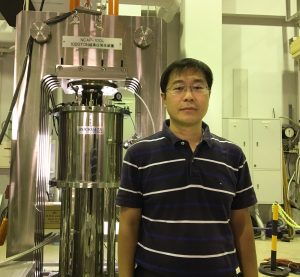ISSP Stay Report of Prof. Jinguang Cheng
Professor Jinguang Cheng
Institute of Physics, Chinese Academy of Sciences

I have stayed in ISSP as a visiting professor during the past three months, which is my second long-term stay in ISSP. I have conducted the JSPS postdoctorate research in Prof. Uwatoko’s group from 2012 to 2014. My postdoctorate experience in ISSP had turned out to be very successful since we discovered superconductivity in CrAs and MnP near their pressure-induced magnetic quantum critical point. With the kind help of Prof. Uwatoko, I quickly established a high-pressure research group at the Institute of Physics, Chinese Academy of Sciences (IOP CAS) in 2014, and since then we have maintained close collaborations in very possible ways. My research interest in IOP CAS focus on the exploration of emergent quantum materials and phenomena under high pressure extreme conditions. During a high pressure study on LiOsO3, the first example of “ferroelectric metal”, we found that the structural transition from low-temperature non-centrosymmetric polar phase to high-temperature centrosymmetric phase increases from Ts = 140 K at ambient pressure to ~ 260 K at 12 GPa. A simple extrapolation of Ts(P) indicates that the polar metallic phase might be stabilized at room temperature under higher pressures. On the other hand, an opposite trend is expected since pressure tends to favor a high symmetry non-polar phase and to enhance the screening of dipole-dipole interactions by conduction electrons. In any case, a study on LiOsO3 to higher pressures is desirable and this idea is supported by Prof. Uwatoko.
The main purpose of my stay in ISSP is thus to investigate LiOsO3 at higher pressures with the recently developed two-stage multianvil apparatus for low-temperature measurements in Prof. Uwatoko’s group. As a newly developed instrument, we have overcome some detailed technical issues during cooling and warming processes when conducting the very first commission of low-temperature measurement with this system. Finally, I have successfully measured the temperature dependence of resistivity on the LiOsO3 single crystal under several pressures up to ~18.6 GPa. From the temperature- and pressure-dependent resistivity, I uncover a possible pressure-induced phase transition at about 16-17 GPa, above which the polar phase seems to be quenched since no resistivity anomaly can be discerned anymore. Further high-pressure structural study on LiOsO3 is planned to confirm this observation. During the course of above experiments and through in-depth discussions with Prof. Uwatoko, we also bring about some ideas to further optimize the performance of this multianvil apparatus. For example, the first-stage guide block can be split and contained in a cylindrical container in order to sustain a larger loading force; some pyrophyllite fins with proper dimensions can be applied to increase the stability and pressure capacity; the configuration of cell assembly inside the octahedral pressure medium should be further optimized in order to increase the success rate of high-pressure experiments, etc. I will continue my effort to test the latter two ideas after I return to IOP CAS. I hope we can perform routine low-temperature experiments to over 20 GPa in this multianvil system through the combined efforts from both sides.
In addition to the multianvil system, I also have the opportunity to access many other facilities in Prof. Uwatoko’s group. By using PPMS and MPMS, I have performed detailed characterizations on the physical properties of marcasite-type MnSb2 synthesized under high-pressure and high-temperature conditions at IOP CAS. The unique dilution refrigerator system for palm-type cubic anvil cells here allows me to examine how the quantum-spin-liquid state of YbMgGaO4 can evolve under pressure. These preliminary studies are expected to result in some collaborative publications in the future.
I am grateful for the opportunity to revisit ISSP and I enjoyed very much my stay in ISSP for the past three months. I have taken the chance to interact closely with the group members and visitors of Prof. Uwatoko’s group. I enjoyed very much after-lunch short walk and discussions with Dr. Dilip Bhoi and Mr. Yufeng Zhang. I have visited Prof. Takahashi’s lab in the Nihon University and learned some knowledge about diamond anvil cells. I appreciated the kind help from Dr. Jun Gouchi, Dr. Yu Shan, and Mr. Kento Ishigaki for the assistance in high-pressure experiments. I am also grateful to Ishiguchi-san and Nagasaki-san, who made the process of settling in quick and simple. I look forward to visiting ISSP and Japan in the future.
